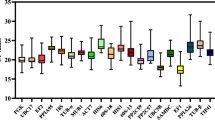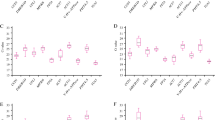Abstract
Quantitative real-time reverse transcription-polymerase chain reaction (qRT-PCR) is a technique that is widely used for gene expression analysis, and its accuracy depends on the expression stability of the internal reference genes used as normalization factors. However, many applications of qRT-PCR used housekeeping genes as internal controls without validation. In this study, the expression stability of eight candidate reference genes in three tissues (intestine, respiratory tree, and muscle) of the sea cucumber Apostichopus japonicus was assessed during normal growth and aestivation using the geNorm, NormFinder, delta CT, and RefFinder algorithms. The results indicate that the reference genes exhibited significantly different expression patterns among the three tissues during aestivation. In general, the β-tubulin (TUBB) gene was relatively stable in the intestine and respiratory tree tissues. The optimal reference gene combination for intestine was 40S ribosomal protein S18 (RPS18), TUBB, and NADH dehydrogenase (NADH); for respiratory tree, it was β-actin (ACTB), TUBB, and succinate dehydrogenase cytochrome B small subunit (SDHC); and for muscle it was α-tubulin (TUBA) and NADH dehydrogenase [ubiquinone] 1 α subcomplex subunit 13 (NDUFA13). These combinations of internal control genes should be considered for use in further studies of gene expression in A. japonicus during aestivation.
Similar content being viewed by others
References
Andersen C L, Jensen J L, Ørntoft T F. 2004. Normalization of real-time quantitative reverse transcription-PCR data: a model-based variance estimation approach to identify genes suited for normalization, applied to bladder and colon cancer data sets. Cancer Research, 64(15): 5 245–5 250.
Araya M T, Siah A, Mateo D, Markham F, McKenna P, Johnson G, Berthe F C. 2008. Selection and evaluation of housekeeping genes for haemocytes of soft-shell clams (Mya arenaria) challenged with Vibrio splendidus. Journal of Invertebrate Pathology, 99(3): 326–331.
Bas A, Forsberg G, Hammarström S, Hammarström M L. 2004. Utility of the housekeeping genes 18S rRNA, β-Actin and glyceraldehyde-3-phosphate-dehydrogenase for normalization in real-time quantitative reverse transcriptase-polymerase chain reaction analysis of gene expression in human T lymphocytes. Scandinavian Journal of Immunology, 59(6): 566–573.
Bower N I, Johnston I A. 2009. Selection of reference genes for expression studies with fish myogenic cell cultures. BMC Molecular Biology, 10(1): 80.
Bustin S A, Nolan T. 2004. Pitfalls of quantitative real-time reverse-transcription polymerase chain reaction. Journal of Biomolecular Techniques, 1(3): 155.
Bustin S, Benes V, Nolan T, Pfaffl M. 2005. Quantitative real-time RT-PCR—a perspective. Journal of Molecular Endocrinology, 34(3): 597–601.
Bustin S. 2005. Real-time PCR. Encyclopedia of diagnostic genomics and proteomics, 10: 1 117–1 125.
Caldana C, Scheible W-R, Mueller-Roeber B, Ruzicic S. 2007. A quantitative RT-PCR platform for high-throughput expression profiling of 2500 rice transcription factors. Plant Methods, 3(1): 7.
Chen H, Takei F, Koay E S-C, Nakatani K, Chu J J H. 2013. A novel DANP-coupled hairpin RT-PCR for rapid detection of chikungunya virus. Journal of Molecular Diagnostics, 15(2): 227–233.
Dong Y W, Ji T T, Meng X L, Dong S L, Sun W M. 2010. Difference in thermotolerance between green and red color variants of the Japanese sea cucumber, Apostichopus japonicus Selenka: Hsp70 and heat hardening effect. Biological Bulletin, 218(1): 87–94.
Du H X, Bao Z M, Hou R, Wang S, Su H L, Yan J J, Tian M L, Li Y, Wei W, Lu W, Hu X L, Wang S, Hu J J. 2012. Transcriptome sequencing and characterization for the sea cucumber Apostichopus japonicus (Selenka, 1867). PloS ONE, 7(3): e33311.
Gao F, Yang H, Xu Q, Wang F, Liu G. 2009. Effect of water temperature on digestive enzyme activity and gut mass in sea cucumber Apostichopus japonicus (Selenka), with special reference to aestivation. Chinese Journal of Oceanology and Limnology, 27(4): 714–722.
Ginzinger D G. 2002. Gene quantification using real-time quantitative PCR: an emerging technology hits the mainstream. Experimental Hematology, 30(6): 503–512.
Heid C A, Stevens J, Livak K J, Williams P M. 1996. Real time quantitative PCR. Genome Research, 6(10): 986–994.
Ji T, Dong Y, Dong S. 2008. Growth and physiological responses in the sea cucumber, Apostichopus japonicus Selenka: Aestivation and temperature. Aquaculture, 283(1): 180–187.
Kapila N, Kishore A, Sodhi M, Sharma A, Kumar P, Mohanty A K, Jerath T, Mukesh M. 2013. Identification of appropriate reference genes for qRT-PCR analysis of heat-stressed mammary epithelial cells in riverine Buffaloes (Bubalus bubalis). ISRN Biotechnology, 2013: 735053, http://dx.doi.org/10.5402/2013/735053.
Kubista M, Andrade J M, Bengtsson M et al. 2006. The realtime polymerase chain reaction. Molecular Aspects of Medicine, 27(2–3): 95–125.
Li F, Liu Y, Song B, Sun H, Gu B, Zhang X. 1996. Study on aestivating habit of sea cucumber (Apostichopus japonicus Selenka): 2. the factors relating to aestivation. Journal of Fishery of Sciences of China, 3: 49–57. (in Chinese)
Li R, Ding J, Zhang Y, Cheng Y, Cao X, Chang Y. 2006. Histological study on the digestive tract of the Apostichopus japonicus in aestivation. Marine Environmental Science, 4: 004. (in Chinese)
Li X, Wang X. 2007. The histological observation of alimentary tract and respiratory tree in sea cucumber, Apostichopus japonicus during aestivation induced in lab. Journal of Dalian Fisheries University, 22: 81–85. (in Chinese)
Li Z, Cui L, Zhou M, Qi X, Bao C, Hu J, Shan J, Wu B, Wang S, Guo X. 2013. Development and application of a onestep real-time RT-PCR using a minor-groove-binding probe for the detection of a novel bunyavirus in clinical specimens. Journal of Medical Virology, 85(2): 370–377.
Liu Y, Li F, Song B, Sun H, Zhang X, Gu B. 1996. Study on aestivating habit of sea cucumber Apostichopus japonicus Selenka: ecological characteristics of aestivation. Journal of Fishery of Sciences of China, 3: 41–48. (in Chinese)
McCurley A T, Callard G V. 2008. Characterization of housekeeping genes in zebrafish: male-female differences and effects of tissue type, developmental stage and chemical treatment. BMC Molecular Biology, 9(1): 102.
Ortiz-Pineda P A, Ramírez-Gómez F, Pérez-Ortiz J, González-Díaz S, Santiago-De Jesús F, Hernández-Pasos J, Del Valle-Avila C, Rojas-Cartagena C, Suárez-Castillo E C, Tossas K. 2009. Gene expression profiling of intestinal regeneration in the sea cucumber. BMC Genomics, 10(1): 262.
Pfaffl M W, Tichopad A, Prgomet C, Neuvians T P. 2004. Determination of stable housekeeping genes, differentially regulated target genes and sample integrity: BestKeeper—excel-based tool using pair-wise correlations. Biotechnology Letters, 26(6): 509–515.
Plusquin M, DeGheselle O, Cuypers A, Geerdens E, Van Roten A, Artois T, Smeets K. 2012. Reference genes for qPCR assays in toxic metal and salinity stress in two flatworm model organisms. Ecotoxicology, 21(2): 475–484.
Qiu R, Sun B, Fang S, Sun L, Liu X. 2013. Identification of normalization factors for quantitative real-time RT-PCR analysis of gene expression in Pacific abalone Haliotis discus hannai. Chinese Journal of Oceanology and Limnology, 31(2): 421–430.
Ransbotyn V, Reusch T B H. 2006. Housekeeping gene selection for quantitative real-time PCR assays in the seagrass Zostera marina subjected to heat stress. Limnology and Oceanography — Methods, 4: 367–373.
Ruan W, Lai M. 2007. Actin, a reliable marker of internal control? Clinica Chimica Acta, 385(1): 1–5.
Selvey S, Thompson E, Matthaei K, Lea R A, Irving M G, Griffiths L. 2001. β-actin—an unsuitable internal control for RT-PCR. Molecular and Cellular Probes, 15(5): 307–311.
Silver N, Best S, Jiang J, Thein S L. 2006. Selection of housekeeping genes for gene expression studies in human reticulocytes using real-time PCR. BMC Molecular Biology, 7(1): 33.
Sloan N A. 1984. Echinodermfisheries of theworld: a review. In: Keegan B F, O’Connor B D S eds. Echinodermata: Proceedings of the Fifth International Echinoderm Conference. AA Balkema Publishers, Rotterdam. p.109–124.
Soong R, Ladányi A. 2003. Improved indicators for assessing the reliability of detection and quantification by kinetic PCR. Clinical Chemistry, 49(6): 973–976.
Spurgeon S L, Jones R C, Ramakrishnan R. 2008. High throughput gene expression measurement with real time PCR in a microfluidic dynamic array. PLoS ONE, 3(2): e1662.
Sun L, Chen M, Yang H, Wang T, Liu B, Shu C, Gardiner D M. 2011. Large scale gene expression profiling during intestine and body wall regeneration in the sea cucumber Apostichopus japonicus. Comparative Biochemistry and Physiology Part D: Genomics and Proteomics, 6(2): 195–205.
Thellin O, Zorzi W, Lakaye B, De Borman B, Coumans B, Hennen G, Grisar T, Igout A, Heinen E. 1999. Housekeeping genes as internal standards: use and limits. Journal of Biotechnology, 75(2): 291–295.
Vandesompele J, De Preter K, Pattyn F, Poppe B, Van Roy N, De Paepe A, Speleman F. 2002. Accurate normalization of real-time quantitative RT-PCR data by geometric averaging of multiple internal control genes. Genome Biology, 3(7): research0034-research0034.11.
Wan H, Zhao Z, Qian C, Sui Y, Malik A A, Chen J. 2010. Selection of appropriate reference genes for gene expression studies by quantitative real-time polymerase chain reaction in cucumber. Analytical Biochemistry, 399(2): 257–261.
Wang F, Yang H, Gabr H R, Gao F. 2008. Immune condition of Apostichopus japonicus during aestivation. Aquaculture, 285(1): 238–243.
Wang Q L, Dong Y W, Qin C X, Yu S S, Dong S L, Wang F. 2013. Effects of rearing temperature on growth, metabolism and thermal tolerance of juvenile sea cucumber, Apostichopus japonicus Selenka: critical thermal maximum (CTmax) and hsps gene expression. Aquaculture Research, 44(10): 1 550–1 559.
Wang T, Yang H, Zhao H, Chen M, Wang B. 2011. Transcriptional changes in epigenetic modifiers associated with gene silencing in the intestine of the sea cucumber, Apostichopus japonicus (Selenka), during aestivation. Chinese Journal of Oceanology and Limnology, 29(6): 1 267–1 274.
Wong M L, Medrano J F. 2005. Real-time PCR for mRNA quantitation. Biotechniques, 39(1): 75.
Yang H, Yuan X, Zhou Y, Mao Y, Zhang T, Liu Y. 2005. Effects of body size and water temperature on food consumption and growth in the sea cucumber Apostichopus japonicus (Selenka) with special reference to aestivation. Aquaculture Research, 36(11): 1 085–1 092.
Yang H, Zhou Y, Zhang T, Yuan X, Li X, Liu Y, Zhang F. 2006. Metabolic characteristics of sea cucumber Apostichopus japonicus (Selenka) during aestivation. Journal of Experimental Marine Biology and Ecology, 330(2): 505–510.
Zhao H, Yang H, Zhao H, Chen M, Wang T. 2011. The molecular characterization and expression of heat shock protein 90 (Hsp90) and 26 (Hsp26) cDNAs in sea cucumber (Apostichopus japonicus). Cell Stress and Chaperones, 16(5): 481–493.
Zhao H, Yang H, Zhao H, Liu S, Wang T. 2012. Differences in MITF gene expression and histology between albino and normal sea cucumbers (Apostichopus japonicus Selenka). Chinese Journal of Oceanology and Limnology, 30(1): 80.
Zhu J F, Zhang L F, Li W F, Han S Y, Yang W H, Qi L W. 2013. Reference gene selection for quantitative real-time PCR normalization in Caragana intermedia under different abiotic stress conditions. PLoS ONE, 8(1): e53196.
Author information
Authors and Affiliations
Corresponding author
Additional information
Supported by the National Nature Science Foundation of China (Nos. 41176139, 31201972)
ZHAO Ye and CHEN Muyan contributed equally to this work.
Rights and permissions
About this article
Cite this article
Zhao, Y., Chen, M., Wang, T. et al. Selection of reference genes for qRT-PCR analysis of gene expression in sea cucumber Apostichopus japonicus during aestivation. Chin. J. Ocean. Limnol. 32, 1248–1256 (2014). https://doi.org/10.1007/s00343-015-4004-2
Received:
Accepted:
Published:
Issue Date:
DOI: https://doi.org/10.1007/s00343-015-4004-2




